Attainment Scotland Fund evaluation: interim report (year 3)
Findings from the evaluation of Year 3 (2017-2018) of implementation of the Attainment Scotland Fund.
3. Interventions and Targeting Approaches
3.1. This chapter focuses on the types of interventions that were implemented as a result of the ASF and how these were planned for and targeted to reduce the poverty-related attainment gap. This is preceded by a brief section exploring engagement with the aims of the ASF.
Engagement with Programme Aims
3.2. Information about the extent to which the aims of the ASF were understood and supported was gathered primarily from the headteacher survey.
3.3. In Year 3 of the ASF, 91% of headteachers felt the aims of the ASF were clear (51% very clear and 40% somewhat clear). This compares to 97% in Year 2 of the ASF and appears to reflect less clarity amongst headteachers of schools only receiving PEF.
Figure 3.1: Clarity of the aims of the ASF, headteacher survey
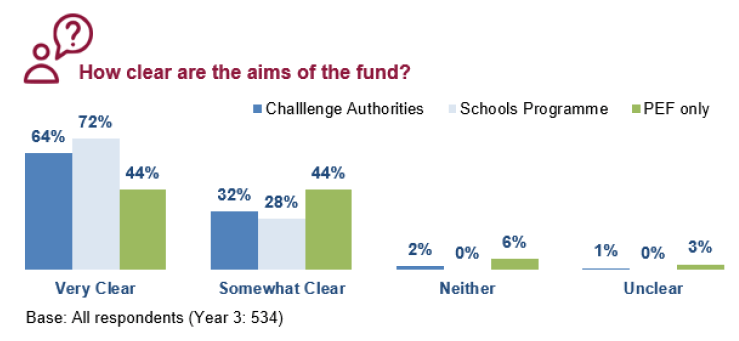
3.4. As in previous years, respondents to the headteacher survey were also asked to report on the extent to which they agreed with the aims of the ASF. Whilst a large majority agreed with the aims of the ASF, there was slightly less agreement than in previous years. This was consistent across respondent groups (96% of Challenge Authority schools agreed; 97% of Schools Programme and 93% of PEF only).
Figure 3.2: Agreement with the aims of the ASF, headteacher survey
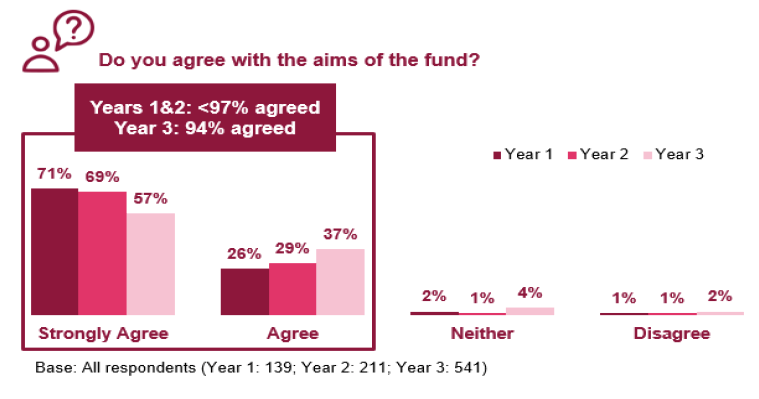
3.5. A small number of headteachers (2% of all survey respondents) indicated in their written comments reasons for not agreeing with the aims of the ASF. This included a belief that the focus of the ASF is too narrow and that allocating PEF on the basis of Free School Meal entitlement disadvantages those where take-up rates are low. Headteachers also raised concerns about the limited impacts that the ASF can have within the context of local cuts in education funding.
3.6. Local authorities also indicated commitment to the aims of the ASF. The long-term outcomes identified by Challenge Authorities in the progress reports for their planned programme of work were in line with those identified nationally.
Interventions and Approaches
3.7. This section focusses on how interventions were organised and planned for; the types of interventions that were implemented; and how these interventions were targeted.
Planning for interventions
3.8. Year 3 was the first year of PEF and the first section focuses on the experiences of local authorities and schools in planning for PEF specifically.
3.9. The local authority mini survey asked both Challenge and non-Challenge Authorities to report on their experience of planning and implementing PEF. As reported in Chapter 2, all authorities provided some kind of support to schools. There was evidence that schools had access to central support in the form of guidance documentation and/or local authority officers (e.g. Quality Improvement Officers).
3.10. In Year 3 of the online survey, 66% of headteachers indicated they felt there was sufficient support in place to help them develop their plans for PEF. This is an increase from 56% in Year 2 of the survey when only schools in receipt of Challenge Authority or Schools Programme participated.
3.11. There was also a decrease in the number of headteachers not feeling there was sufficient support in place (25% in Year 3 compared to 37% in Year 2).
Figure 3.3: Sufficient support in place, headteacher survey
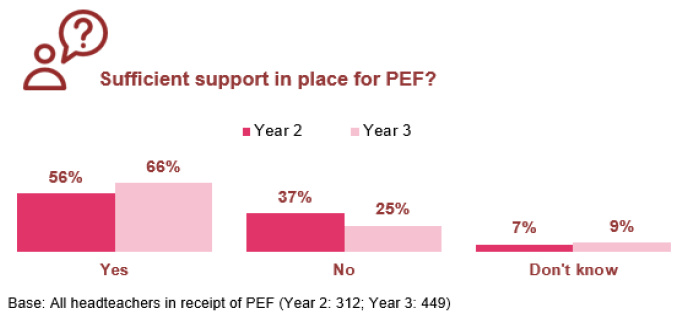
3.12. For those who did not feel there had been sufficient support, this was most commonly because of insufficient time in planning following the 2017/18 allocation of funding.
3.13. Insufficient time for planning following the 2017/18 notification of PEF allocation was also a common feature of the evidence from case studies. There was however emerging evidence that planning in 2018/19 had benefitted from longer timescales. This will be explored further in the evaluation for Year 4.
3.14. Headteachers also reported that they used a range of sources to develop plans for PEF. Over 70% of headteachers reported using either local guidance, teachers in the school, national operational guidance, parents or local authority more generally.
Figure 3.4: Sources used to develop plans for PEF, headteacher survey
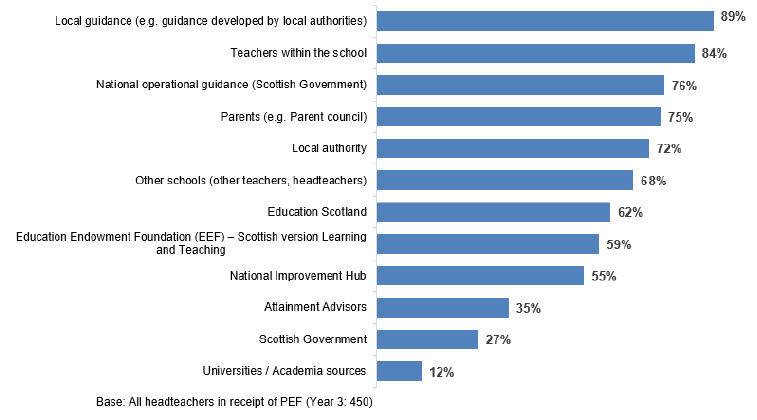
3.15. Where schools had received both Challenge Authority or Schools Programme funding and Pupil Equity Funding, headteachers were asked to indicate if they had created 2 distinct schools plans or whether they had a single school plan.
3.16. Overall, more respondents indicated having a single school plan (61%) compared to using 2 separate plans (35%).
3.17. However, there were some differences across funding streams. Those in Challenge Authorities also receiving PEF were more likely to report having a single school plan than headteachers receiving both Schools Programme funding and PEF.
Figure 3.5: Plans for implementing funded interventions, headteacher survey
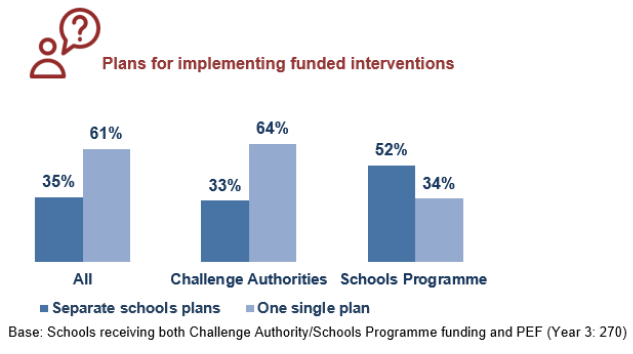
3.18. The evaluation also considered the extent to which plans changed over time.
3.19. Headteachers responding to the online survey were asked to indicate to what extent their interventions (supported by any of the funding streams) were new, a scale up from previous year or continuing at the same level. Across both Year 2 and 3, respondents most commonly indicated that the interventions were newly introduced.
3.20. In Year 3 of the headteacher survey, there was an increase in those reporting that most interventions were newly introduced and a reduction in those reporting that most interventions were a scale up of an intervention implemented in previous year. This reflects the inclusion of PEF-only schools; 61% reported that most interventions were newly introduced compared to 30% of Schools Programme schools and 47% of Challenge Authority schools.
3.21. Schools receiving both Challenge Authority or Schools Programme funding and PEF were asked whether they had stopped or were planning to stop any interventions supported by the ASF.
3.22. Overall, only a small proportion of headteachers indicated stopping interventions. In relation to interventions supported by Challenge Authority or Schools Programme funding, 11% of headteachers indicated they had stopped or were planning to stop interventions. This compared to 20% of headteachers indicating they had stopped/were planning to stop PEF supported interventions.
3.23. A small number of headteachers provided reasons for stopping interventions in their written comments. Commonly reported reasons for stopping interventions included, in order of frequency:
- Lack of any evidence of impact,
- Reduction in resources, including financial and staffing
- Change of focus over time (e.g. between literacy, numeracy and health & wellbeing)
- Feedback from pupils, parents or teachers
- Changes in local authority priorities
Type of interventions
3.24. In their progress reports, Challenge Authorities reported on the interventions they were implementing around literacy, numeracy and health and wellbeing. Interventions on literacy and numeracy were prominent in the primary programme. There was also some evidence that secondary school interventions tended to focus more health and wellbeing.
3.25. There was some evidence from the school case studies that schools with relatively less funding were more likely plan work that supported existing interventions. Those with higher allocations reported more interventions that also had broader scope.
3.26. In the headteacher survey, respondents were asked to list interventions supported in their school during 2017/18 by Challenge Authority, Schools Programme or Pupil Equity Funding. Of those providing details of their interventions, most schools referred to interventions across all areas of literacy, numeracy and health and wellbeing.
3.27. From the Challenge Authority progress reports, there was some evidence that progress was still balanced in favour of the primary schools. This will be important to continue to explore in the evaluation of Year 4.
3.28. Challenge Authority funding was also used to support interventions in the Early Years and at least 4 authorities had developed this as part of their formal strategy.
3.29. Challenge Authorities also focused their interventions on leadership, parental engagement/families and communities, and data analysis.
3.30. In line with the findings from Years 1 and 2, 93% of headteachers reported that there was at least some focus on teaching skills or practice. However, whereas in Year 2, 76% reported a strong emphasis, in Year 3, only 57% reported a strong emphasis. Challenge Authority schools were more likely than schools only in receipt of PEF to report a strong emphasis.
3.31. Figure 3.6 below shows reported emphasis on other potential areas of focus. This list of areas changed from Years 2 to 3 of the survey and therefore is not directly comparable.
Figure 3.6: Focus of interventions, headteacher survey
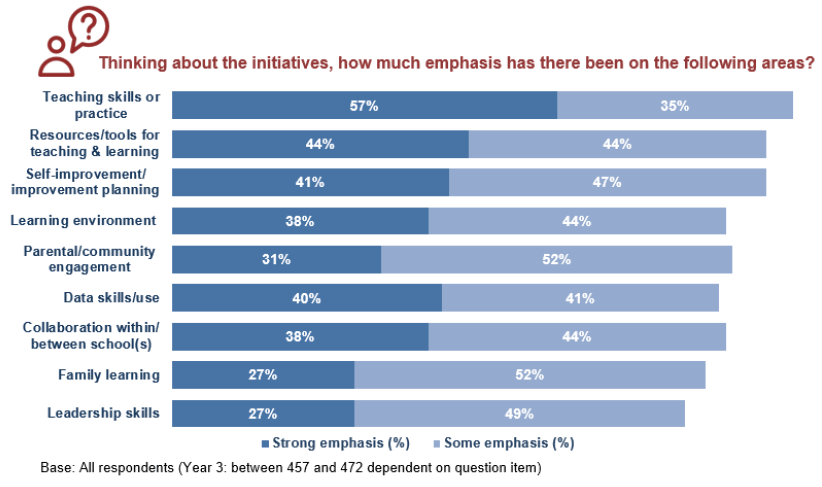
Targeting interventions
3.32. In Year 3, there was evidence of both targeting and universal approaches at local authority and school level.
3.33. Challenge Authorities generally indicated that all schools in their local authority had access to ASF support, with some specific targeting for certain schools or interventions.
3.34. There was evidence that measures of deprivation were being used to target interventions. Outwith the universal offer, some schools within Challenge Authorities were specifically targeted based on socio-economic characteristics.
3.35. Challenge Authorities also reported using other characteristics to target their improvement activity. For example, additional support needs, which included having English as an additional language or being care experienced, were often taken into consideration.
3.36. At the school level, 73% of headteachers indicated that most of their interventions were targeted at pupils or parents living in the most deprived areas. This was consistent with results from Year 2.
3.37. Over half (58%) of respondents also reported targeting at least some of their interventions in ‘other’ ways. A total of 153 respondents provided a description of these other ways. This included using attainment or attendance, exclusion or risk of exclusion data. Headteachers also looked to individual characteristics when targeting their interventions, including: additional support needs; care experienced; adverse childhood experiences and having English as an additional language. Finally, a lack of family engagement was reported by a few respondents as the basis for targeting.
3.38. Other information on approaches to targeting came from the school case studies. As reported by Challenge Authorities, schools often extended the reach of their interventions beyond measures of deprivation, such as Free School Meals. Schools considered a range of additional support needs such as care-experienced pupils, those with English as an additional language or those facing Adverse Childhood Experiences. They also drew on attainment related evidence when targeting their programme of improvement activity.
3.39. Qualitative evidence from the case studies suggested that, associated with a targeted approach was an increased awareness amongst staff of the impact of poverty on attainment. This resonates with the findings from Years 1 and 2.
3.40. In addition, it seemed that the profile of the school influenced the nature of targeted approaches. For example, schools with a large proportion of their school roll from the most deprived areas needed to take into consideration other criteria in order to prioritise resources. For schools with a very small proportion of their school role registered for FSM, consideration of wider range of needs helped ensure an inclusive approach.
Contact
Email: socialresearch@gov.scot
There is a problem
Thanks for your feedback